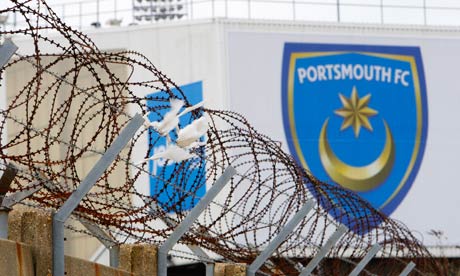
Portsmouth's financial woes may be reaching an end but Coventry's stadium issues also offer a grim lesson.
The battle over Fratton Park is shortly to be resolved in court (1). The twisted history of Portsmouth's financial ills and, indeed, its ownership ills seem to be moving towards a denouement (the topics of the stadium which has become separated from its club in ownership terms, and the mixed blessing that a new stadium can bring, are ones that I have covered in previous postings (see postings passim). Certainly as a member of the Pompey Supporters Trust, and a strong advocate of fan ownership, I want the Trust to "win" the case (they are not a directly participating party, hence the quotation marks). The case for a much lower valuation is a strong one, and for once I'm optimistic that the result will, for once, go the right way. If it doesn't, it will almost certainly mean the liquidation of the club, and the fight to establish a resurrection club will begin in earnest no doubt.
Nearer to home, literally, as I live in work in Coventry, if not metaphorically, the issue of the ownership of the Ricoh is almost as prominent on my radar.
Its origins go back to the heady days when Coventry was enjoying a notably long and unbroken run in the top flight, dating back to 1967 and the managership of Jimmy Hill. Its then stadium at Highfield Road dated from 1899, and, with a post-Taylor capacity of approximately 23,500, it lacked any of the facilities that a Premier League stadium needed to compete from a business point of view. It was not a million miles from Fratton Park to be honest.
In 1997, under the Chairmanship of Bryan Richardson, grand plans were announced for an ultra-modern stadium to be built on a brown-field site on the northern edge of the city, close by Junction three of the M6 (and adjacent to the Coventry-Nuneaton railway line). Arena 2000, as it was originally to be called, was to be the envy of many a self-respecting Premier League, with a retractable roof and a removable pitch, making it ideal for other revenue-generating activities such as pop concerts. What could possibly go wrong?
Well, just about everything:
The brown-field site, which had been the site of Foleshill Gasworks, proved problematic. Contamination of the site required two years of remedial work to make it reusable (2).
The club was being operated unsustainably. By 2003 debts were at a level of £20m (3) and continued to rise (4) and rise (5).
On the pitch, Gordon Strachan failed in the battle to keep the club up in 2001.
In 2002 it was only possible for the building project to continue with the formation of a new joint company, Arena Coventry Limited (6), 50% owned by Coventry City Council and 50% by the Alan Edward Higgs Charity, a wealthy local charity for children which has a strong sports interest.
Sponsorship of the stadium by local car manufacturer Jaguar, itself under financial pressure, fell through as production of their cars in Coventry ceased (7).
To cut a long and tortuous story short, the stadium was built, but to a significantly lower specification than originally planned (capacity was reduced to 32,500), Ricoh took on the sponsorship, and Championship Coventry played their first game there in 2005. Not that this proved a particular turning point for the club. In 2007 a potentially club-saving takeover by American consortium Manhattan Sports Capital Partners fell through (8). Then, having come within twenty-five minutes of going into Administration, the club was acquired by venture capitalists SISU (9).
Although SISU planned to buy at least the 50% of the shares owned by the Alan Edward Higgs Charity, this has not happened, and the club continues to rent the stadium from Arena Coventry Limited. From the club's financial perspective, the stadium is thus a monthly liability rather than the major asset and revenue generator originally envisaged.
Relegation from the Championship to League 1 in 2011 exacerbated an already difficult situation. Attendances and revenues were hit. The agreed rent, reported to be £100,000 per month, became significantly unrealistic for a League 1 club to sustain. Again cutting a long story short, the owners and club have been unable to agree a compromise rent that is realistic, and the club, SISU that is, started a 'rent strike' in March last year (10). Obviously this is a situation that cannot run on indefinitely, and in the last few weeks matters have come to a head, with both sides apparently digging their heels in and maintaining collision course. On the one hand, Deputy Conservative leader John Blundell says that ACL may have to seek a winding-up order over the unpaid arrears (11), while on the other Coventry City Chief Executive Tim Fisher accuses Arena Coventry Limited of pulling out of talks (12). Whatever the rights and wrongs of the respective protagonists, some compromise needs to be reached, and rapidly.
As well as the two confrontational tales of Fratton Park and the Ricoh, there is a crumb of comfort on the stadium front at Stockport County's Edgeley Park (13) where a deal has been announced that will see the club running the stadium at a reduced rent and retaining the revenues from it. Let's hope there will positive news to report shortly from both Coventry and Portsmouth.
• This is an article from our Guardian Sport Network. To find out more about it click here.
• This article first appeared on John Beech's Football Management blog.
No comments:
Post a Comment